Comprehensive Report on Corporation and Business Law Principles
VerifiedAdded on 2023/04/08
|8
|2155
|283
Report
AI Summary
This report provides an analysis of corporation and business law, focusing on different business structures such as sole traders, partnerships, and proprietary companies. It discusses the liabilities and responsibilities associated with each structure, referencing the Fair Work Act, Partnership Act, and Corporations Act. The report details the legal implications for partners and shareholders, emphasizing their rights, duties, and potential liabilities. It further elaborates on the role and obligations of company directors, highlighting their duty of care and the importance of acting in the best interest of the company and its shareholders. The document concludes by underscoring the legal and ethical considerations crucial for operating within the framework of corporation and business law. Desklib offers more solved assignments and past papers for students.

Running head: CORPORATION AND BUSINESS LAW
Corporation and Business Law
Name of the Student
Name of the University
Author Note
Corporation and Business Law
Name of the Student
Name of the University
Author Note
Paraphrase This Document
Need a fresh take? Get an instant paraphrase of this document with our AI Paraphraser
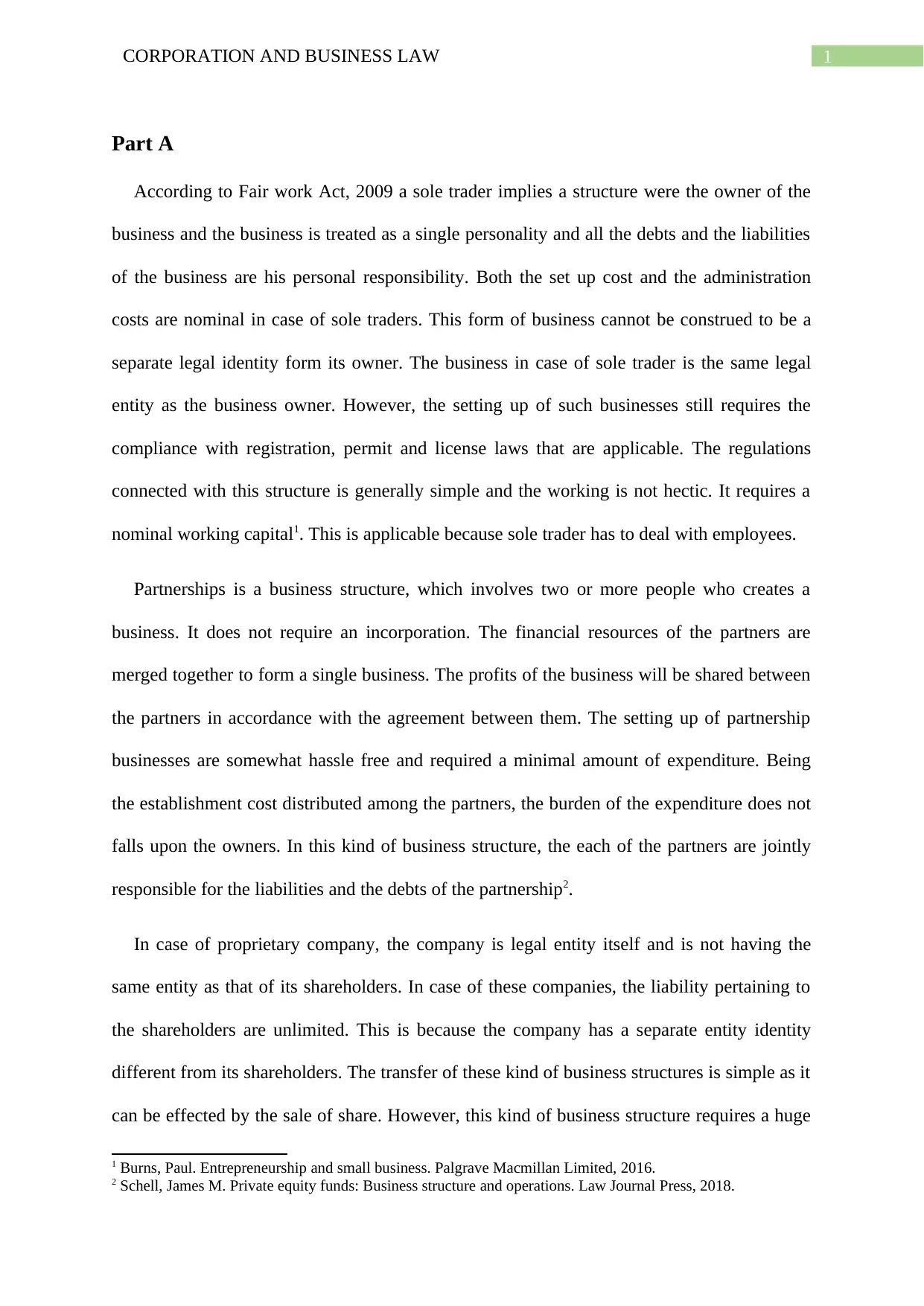
1CORPORATION AND BUSINESS LAW
Part A
According to Fair work Act, 2009 a sole trader implies a structure were the owner of the
business and the business is treated as a single personality and all the debts and the liabilities
of the business are his personal responsibility. Both the set up cost and the administration
costs are nominal in case of sole traders. This form of business cannot be construed to be a
separate legal identity form its owner. The business in case of sole trader is the same legal
entity as the business owner. However, the setting up of such businesses still requires the
compliance with registration, permit and license laws that are applicable. The regulations
connected with this structure is generally simple and the working is not hectic. It requires a
nominal working capital1. This is applicable because sole trader has to deal with employees.
Partnerships is a business structure, which involves two or more people who creates a
business. It does not require an incorporation. The financial resources of the partners are
merged together to form a single business. The profits of the business will be shared between
the partners in accordance with the agreement between them. The setting up of partnership
businesses are somewhat hassle free and required a minimal amount of expenditure. Being
the establishment cost distributed among the partners, the burden of the expenditure does not
falls upon the owners. In this kind of business structure, the each of the partners are jointly
responsible for the liabilities and the debts of the partnership2.
In case of proprietary company, the company is legal entity itself and is not having the
same entity as that of its shareholders. In case of these companies, the liability pertaining to
the shareholders are unlimited. This is because the company has a separate entity identity
different from its shareholders. The transfer of these kind of business structures is simple as it
can be effected by the sale of share. However, this kind of business structure requires a huge
1 Burns, Paul. Entrepreneurship and small business. Palgrave Macmillan Limited, 2016.
2 Schell, James M. Private equity funds: Business structure and operations. Law Journal Press, 2018.
Part A
According to Fair work Act, 2009 a sole trader implies a structure were the owner of the
business and the business is treated as a single personality and all the debts and the liabilities
of the business are his personal responsibility. Both the set up cost and the administration
costs are nominal in case of sole traders. This form of business cannot be construed to be a
separate legal identity form its owner. The business in case of sole trader is the same legal
entity as the business owner. However, the setting up of such businesses still requires the
compliance with registration, permit and license laws that are applicable. The regulations
connected with this structure is generally simple and the working is not hectic. It requires a
nominal working capital1. This is applicable because sole trader has to deal with employees.
Partnerships is a business structure, which involves two or more people who creates a
business. It does not require an incorporation. The financial resources of the partners are
merged together to form a single business. The profits of the business will be shared between
the partners in accordance with the agreement between them. The setting up of partnership
businesses are somewhat hassle free and required a minimal amount of expenditure. Being
the establishment cost distributed among the partners, the burden of the expenditure does not
falls upon the owners. In this kind of business structure, the each of the partners are jointly
responsible for the liabilities and the debts of the partnership2.
In case of proprietary company, the company is legal entity itself and is not having the
same entity as that of its shareholders. In case of these companies, the liability pertaining to
the shareholders are unlimited. This is because the company has a separate entity identity
different from its shareholders. The transfer of these kind of business structures is simple as it
can be effected by the sale of share. However, this kind of business structure requires a huge
1 Burns, Paul. Entrepreneurship and small business. Palgrave Macmillan Limited, 2016.
2 Schell, James M. Private equity funds: Business structure and operations. Law Journal Press, 2018.
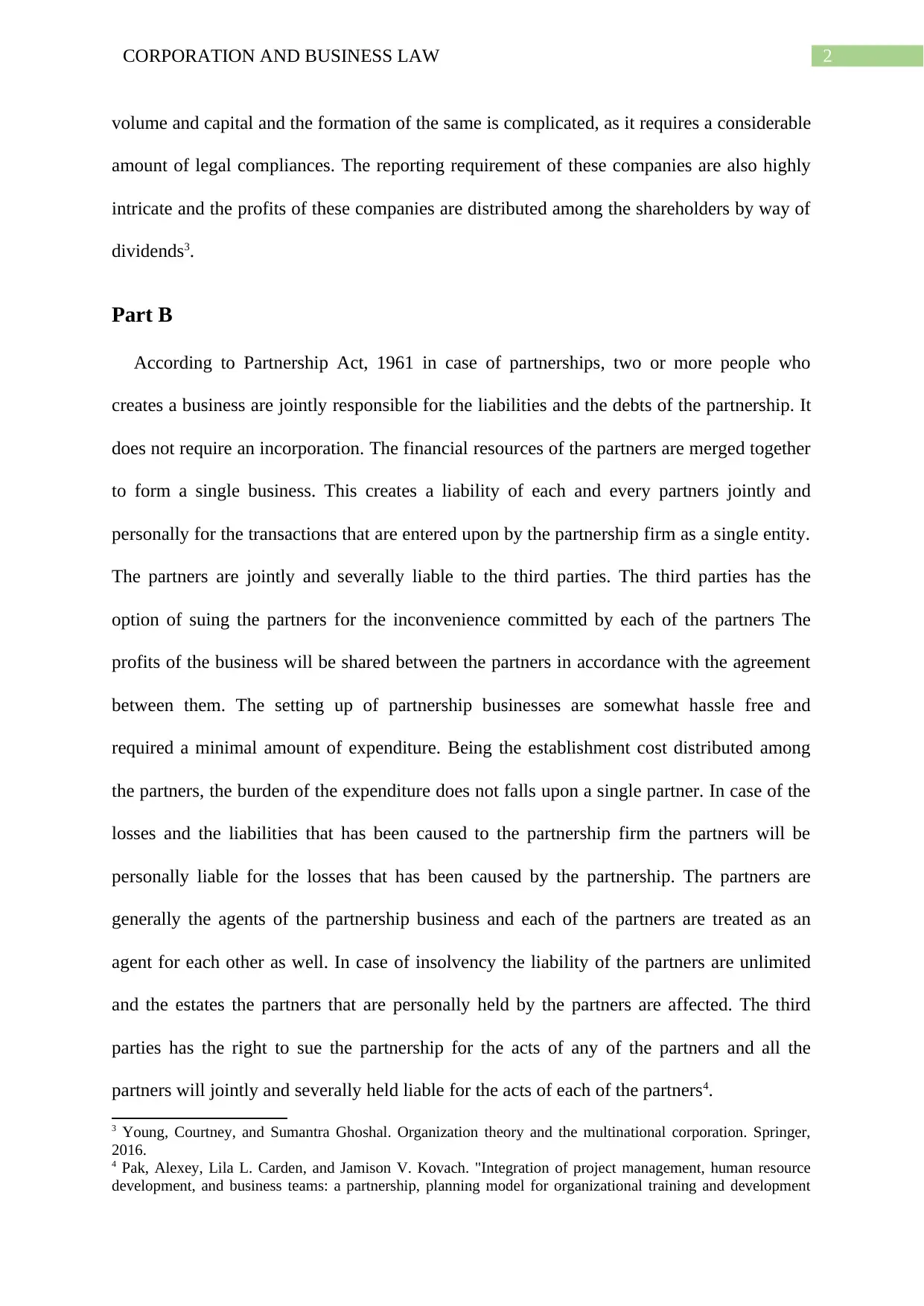
2CORPORATION AND BUSINESS LAW
volume and capital and the formation of the same is complicated, as it requires a considerable
amount of legal compliances. The reporting requirement of these companies are also highly
intricate and the profits of these companies are distributed among the shareholders by way of
dividends3.
Part B
According to Partnership Act, 1961 in case of partnerships, two or more people who
creates a business are jointly responsible for the liabilities and the debts of the partnership. It
does not require an incorporation. The financial resources of the partners are merged together
to form a single business. This creates a liability of each and every partners jointly and
personally for the transactions that are entered upon by the partnership firm as a single entity.
The partners are jointly and severally liable to the third parties. The third parties has the
option of suing the partners for the inconvenience committed by each of the partners The
profits of the business will be shared between the partners in accordance with the agreement
between them. The setting up of partnership businesses are somewhat hassle free and
required a minimal amount of expenditure. Being the establishment cost distributed among
the partners, the burden of the expenditure does not falls upon a single partner. In case of the
losses and the liabilities that has been caused to the partnership firm the partners will be
personally liable for the losses that has been caused by the partnership. The partners are
generally the agents of the partnership business and each of the partners are treated as an
agent for each other as well. In case of insolvency the liability of the partners are unlimited
and the estates the partners that are personally held by the partners are affected. The third
parties has the right to sue the partnership for the acts of any of the partners and all the
partners will jointly and severally held liable for the acts of each of the partners4.
3 Young, Courtney, and Sumantra Ghoshal. Organization theory and the multinational corporation. Springer,
2016.
4 Pak, Alexey, Lila L. Carden, and Jamison V. Kovach. "Integration of project management, human resource
development, and business teams: a partnership, planning model for organizational training and development
volume and capital and the formation of the same is complicated, as it requires a considerable
amount of legal compliances. The reporting requirement of these companies are also highly
intricate and the profits of these companies are distributed among the shareholders by way of
dividends3.
Part B
According to Partnership Act, 1961 in case of partnerships, two or more people who
creates a business are jointly responsible for the liabilities and the debts of the partnership. It
does not require an incorporation. The financial resources of the partners are merged together
to form a single business. This creates a liability of each and every partners jointly and
personally for the transactions that are entered upon by the partnership firm as a single entity.
The partners are jointly and severally liable to the third parties. The third parties has the
option of suing the partners for the inconvenience committed by each of the partners The
profits of the business will be shared between the partners in accordance with the agreement
between them. The setting up of partnership businesses are somewhat hassle free and
required a minimal amount of expenditure. Being the establishment cost distributed among
the partners, the burden of the expenditure does not falls upon a single partner. In case of the
losses and the liabilities that has been caused to the partnership firm the partners will be
personally liable for the losses that has been caused by the partnership. The partners are
generally the agents of the partnership business and each of the partners are treated as an
agent for each other as well. In case of insolvency the liability of the partners are unlimited
and the estates the partners that are personally held by the partners are affected. The third
parties has the right to sue the partnership for the acts of any of the partners and all the
partners will jointly and severally held liable for the acts of each of the partners4.
3 Young, Courtney, and Sumantra Ghoshal. Organization theory and the multinational corporation. Springer,
2016.
4 Pak, Alexey, Lila L. Carden, and Jamison V. Kovach. "Integration of project management, human resource
development, and business teams: a partnership, planning model for organizational training and development
⊘ This is a preview!⊘
Do you want full access?
Subscribe today to unlock all pages.

Trusted by 1+ million students worldwide
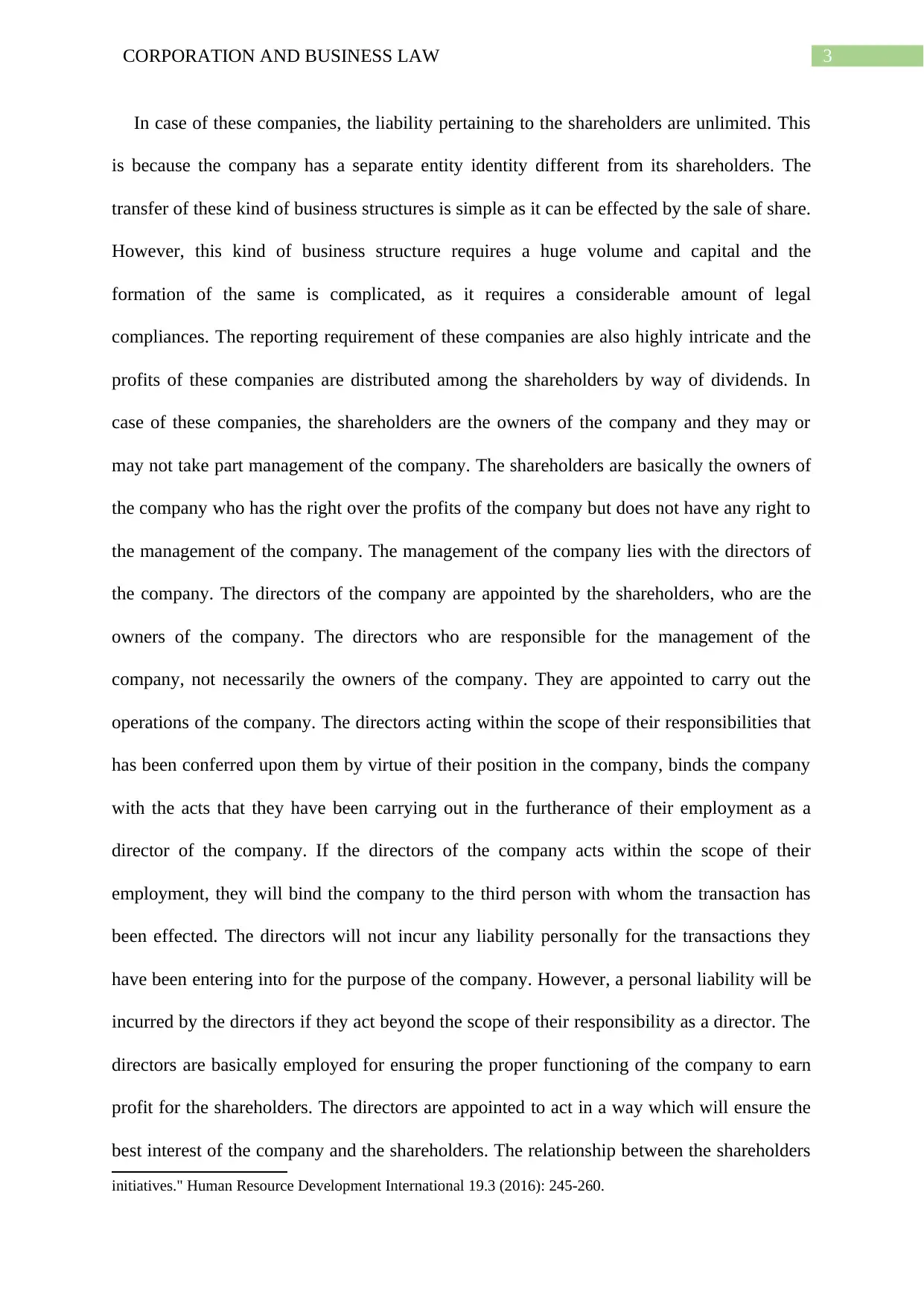
3CORPORATION AND BUSINESS LAW
In case of these companies, the liability pertaining to the shareholders are unlimited. This
is because the company has a separate entity identity different from its shareholders. The
transfer of these kind of business structures is simple as it can be effected by the sale of share.
However, this kind of business structure requires a huge volume and capital and the
formation of the same is complicated, as it requires a considerable amount of legal
compliances. The reporting requirement of these companies are also highly intricate and the
profits of these companies are distributed among the shareholders by way of dividends. In
case of these companies, the shareholders are the owners of the company and they may or
may not take part management of the company. The shareholders are basically the owners of
the company who has the right over the profits of the company but does not have any right to
the management of the company. The management of the company lies with the directors of
the company. The directors of the company are appointed by the shareholders, who are the
owners of the company. The directors who are responsible for the management of the
company, not necessarily the owners of the company. They are appointed to carry out the
operations of the company. The directors acting within the scope of their responsibilities that
has been conferred upon them by virtue of their position in the company, binds the company
with the acts that they have been carrying out in the furtherance of their employment as a
director of the company. If the directors of the company acts within the scope of their
employment, they will bind the company to the third person with whom the transaction has
been effected. The directors will not incur any liability personally for the transactions they
have been entering into for the purpose of the company. However, a personal liability will be
incurred by the directors if they act beyond the scope of their responsibility as a director. The
directors are basically employed for ensuring the proper functioning of the company to earn
profit for the shareholders. The directors are appointed to act in a way which will ensure the
best interest of the company and the shareholders. The relationship between the shareholders
initiatives." Human Resource Development International 19.3 (2016): 245-260.
In case of these companies, the liability pertaining to the shareholders are unlimited. This
is because the company has a separate entity identity different from its shareholders. The
transfer of these kind of business structures is simple as it can be effected by the sale of share.
However, this kind of business structure requires a huge volume and capital and the
formation of the same is complicated, as it requires a considerable amount of legal
compliances. The reporting requirement of these companies are also highly intricate and the
profits of these companies are distributed among the shareholders by way of dividends. In
case of these companies, the shareholders are the owners of the company and they may or
may not take part management of the company. The shareholders are basically the owners of
the company who has the right over the profits of the company but does not have any right to
the management of the company. The management of the company lies with the directors of
the company. The directors of the company are appointed by the shareholders, who are the
owners of the company. The directors who are responsible for the management of the
company, not necessarily the owners of the company. They are appointed to carry out the
operations of the company. The directors acting within the scope of their responsibilities that
has been conferred upon them by virtue of their position in the company, binds the company
with the acts that they have been carrying out in the furtherance of their employment as a
director of the company. If the directors of the company acts within the scope of their
employment, they will bind the company to the third person with whom the transaction has
been effected. The directors will not incur any liability personally for the transactions they
have been entering into for the purpose of the company. However, a personal liability will be
incurred by the directors if they act beyond the scope of their responsibility as a director. The
directors are basically employed for ensuring the proper functioning of the company to earn
profit for the shareholders. The directors are appointed to act in a way which will ensure the
best interest of the company and the shareholders. The relationship between the shareholders
initiatives." Human Resource Development International 19.3 (2016): 245-260.
Paraphrase This Document
Need a fresh take? Get an instant paraphrase of this document with our AI Paraphraser
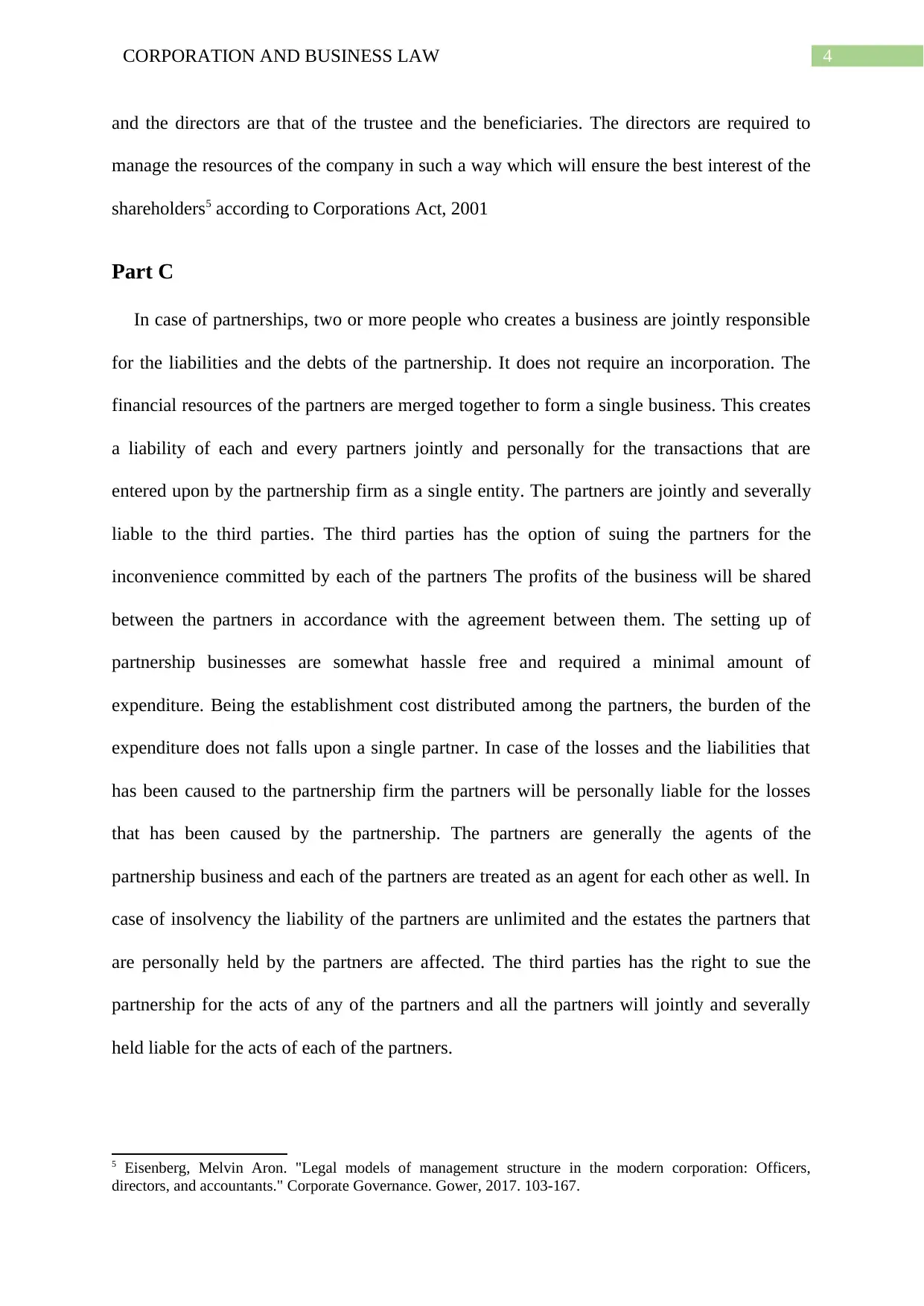
4CORPORATION AND BUSINESS LAW
and the directors are that of the trustee and the beneficiaries. The directors are required to
manage the resources of the company in such a way which will ensure the best interest of the
shareholders5 according to Corporations Act, 2001
Part C
In case of partnerships, two or more people who creates a business are jointly responsible
for the liabilities and the debts of the partnership. It does not require an incorporation. The
financial resources of the partners are merged together to form a single business. This creates
a liability of each and every partners jointly and personally for the transactions that are
entered upon by the partnership firm as a single entity. The partners are jointly and severally
liable to the third parties. The third parties has the option of suing the partners for the
inconvenience committed by each of the partners The profits of the business will be shared
between the partners in accordance with the agreement between them. The setting up of
partnership businesses are somewhat hassle free and required a minimal amount of
expenditure. Being the establishment cost distributed among the partners, the burden of the
expenditure does not falls upon a single partner. In case of the losses and the liabilities that
has been caused to the partnership firm the partners will be personally liable for the losses
that has been caused by the partnership. The partners are generally the agents of the
partnership business and each of the partners are treated as an agent for each other as well. In
case of insolvency the liability of the partners are unlimited and the estates the partners that
are personally held by the partners are affected. The third parties has the right to sue the
partnership for the acts of any of the partners and all the partners will jointly and severally
held liable for the acts of each of the partners.
5 Eisenberg, Melvin Aron. "Legal models of management structure in the modern corporation: Officers,
directors, and accountants." Corporate Governance. Gower, 2017. 103-167.
and the directors are that of the trustee and the beneficiaries. The directors are required to
manage the resources of the company in such a way which will ensure the best interest of the
shareholders5 according to Corporations Act, 2001
Part C
In case of partnerships, two or more people who creates a business are jointly responsible
for the liabilities and the debts of the partnership. It does not require an incorporation. The
financial resources of the partners are merged together to form a single business. This creates
a liability of each and every partners jointly and personally for the transactions that are
entered upon by the partnership firm as a single entity. The partners are jointly and severally
liable to the third parties. The third parties has the option of suing the partners for the
inconvenience committed by each of the partners The profits of the business will be shared
between the partners in accordance with the agreement between them. The setting up of
partnership businesses are somewhat hassle free and required a minimal amount of
expenditure. Being the establishment cost distributed among the partners, the burden of the
expenditure does not falls upon a single partner. In case of the losses and the liabilities that
has been caused to the partnership firm the partners will be personally liable for the losses
that has been caused by the partnership. The partners are generally the agents of the
partnership business and each of the partners are treated as an agent for each other as well. In
case of insolvency the liability of the partners are unlimited and the estates the partners that
are personally held by the partners are affected. The third parties has the right to sue the
partnership for the acts of any of the partners and all the partners will jointly and severally
held liable for the acts of each of the partners.
5 Eisenberg, Melvin Aron. "Legal models of management structure in the modern corporation: Officers,
directors, and accountants." Corporate Governance. Gower, 2017. 103-167.
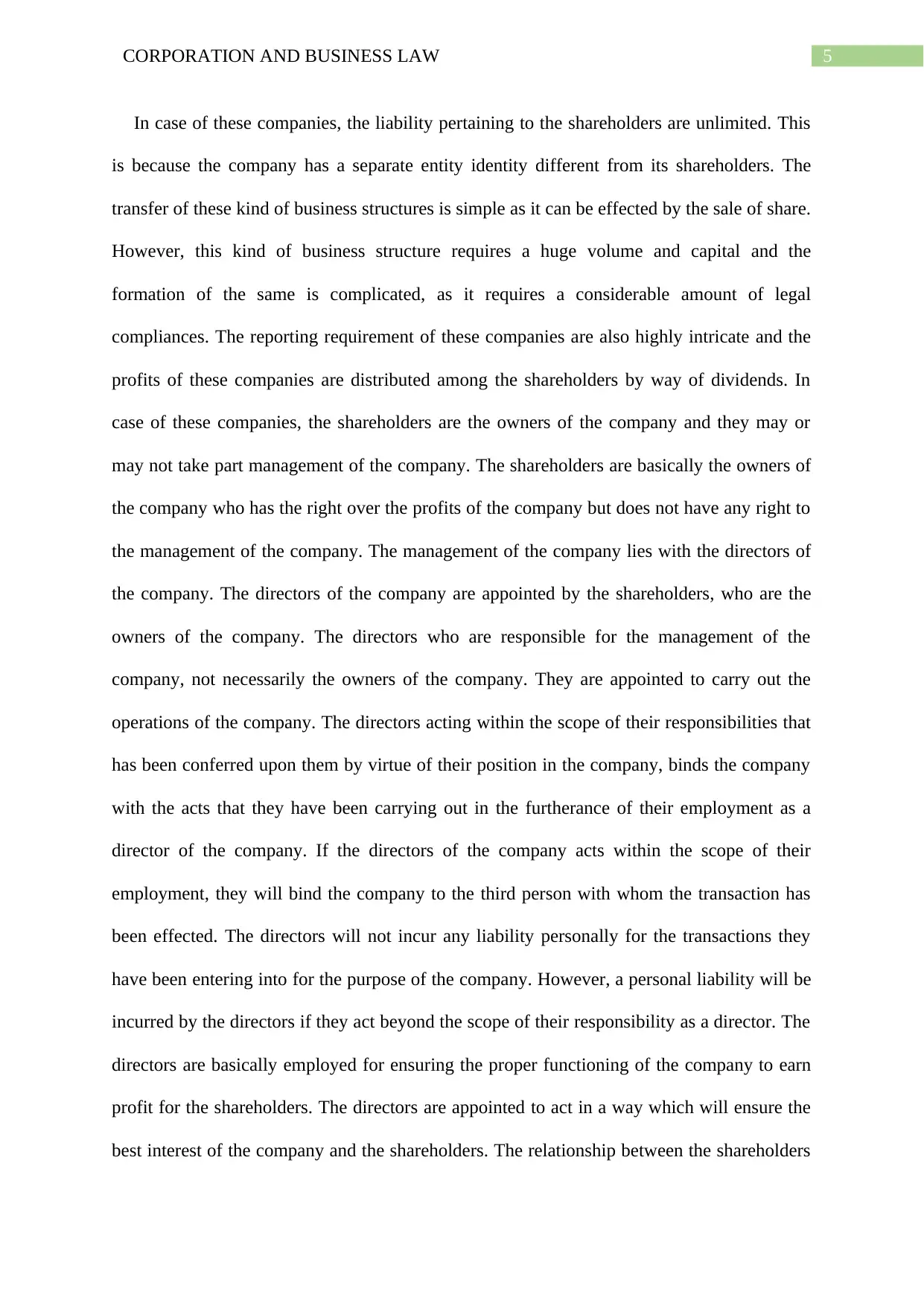
5CORPORATION AND BUSINESS LAW
In case of these companies, the liability pertaining to the shareholders are unlimited. This
is because the company has a separate entity identity different from its shareholders. The
transfer of these kind of business structures is simple as it can be effected by the sale of share.
However, this kind of business structure requires a huge volume and capital and the
formation of the same is complicated, as it requires a considerable amount of legal
compliances. The reporting requirement of these companies are also highly intricate and the
profits of these companies are distributed among the shareholders by way of dividends. In
case of these companies, the shareholders are the owners of the company and they may or
may not take part management of the company. The shareholders are basically the owners of
the company who has the right over the profits of the company but does not have any right to
the management of the company. The management of the company lies with the directors of
the company. The directors of the company are appointed by the shareholders, who are the
owners of the company. The directors who are responsible for the management of the
company, not necessarily the owners of the company. They are appointed to carry out the
operations of the company. The directors acting within the scope of their responsibilities that
has been conferred upon them by virtue of their position in the company, binds the company
with the acts that they have been carrying out in the furtherance of their employment as a
director of the company. If the directors of the company acts within the scope of their
employment, they will bind the company to the third person with whom the transaction has
been effected. The directors will not incur any liability personally for the transactions they
have been entering into for the purpose of the company. However, a personal liability will be
incurred by the directors if they act beyond the scope of their responsibility as a director. The
directors are basically employed for ensuring the proper functioning of the company to earn
profit for the shareholders. The directors are appointed to act in a way which will ensure the
best interest of the company and the shareholders. The relationship between the shareholders
In case of these companies, the liability pertaining to the shareholders are unlimited. This
is because the company has a separate entity identity different from its shareholders. The
transfer of these kind of business structures is simple as it can be effected by the sale of share.
However, this kind of business structure requires a huge volume and capital and the
formation of the same is complicated, as it requires a considerable amount of legal
compliances. The reporting requirement of these companies are also highly intricate and the
profits of these companies are distributed among the shareholders by way of dividends. In
case of these companies, the shareholders are the owners of the company and they may or
may not take part management of the company. The shareholders are basically the owners of
the company who has the right over the profits of the company but does not have any right to
the management of the company. The management of the company lies with the directors of
the company. The directors of the company are appointed by the shareholders, who are the
owners of the company. The directors who are responsible for the management of the
company, not necessarily the owners of the company. They are appointed to carry out the
operations of the company. The directors acting within the scope of their responsibilities that
has been conferred upon them by virtue of their position in the company, binds the company
with the acts that they have been carrying out in the furtherance of their employment as a
director of the company. If the directors of the company acts within the scope of their
employment, they will bind the company to the third person with whom the transaction has
been effected. The directors will not incur any liability personally for the transactions they
have been entering into for the purpose of the company. However, a personal liability will be
incurred by the directors if they act beyond the scope of their responsibility as a director. The
directors are basically employed for ensuring the proper functioning of the company to earn
profit for the shareholders. The directors are appointed to act in a way which will ensure the
best interest of the company and the shareholders. The relationship between the shareholders
⊘ This is a preview!⊘
Do you want full access?
Subscribe today to unlock all pages.

Trusted by 1+ million students worldwide
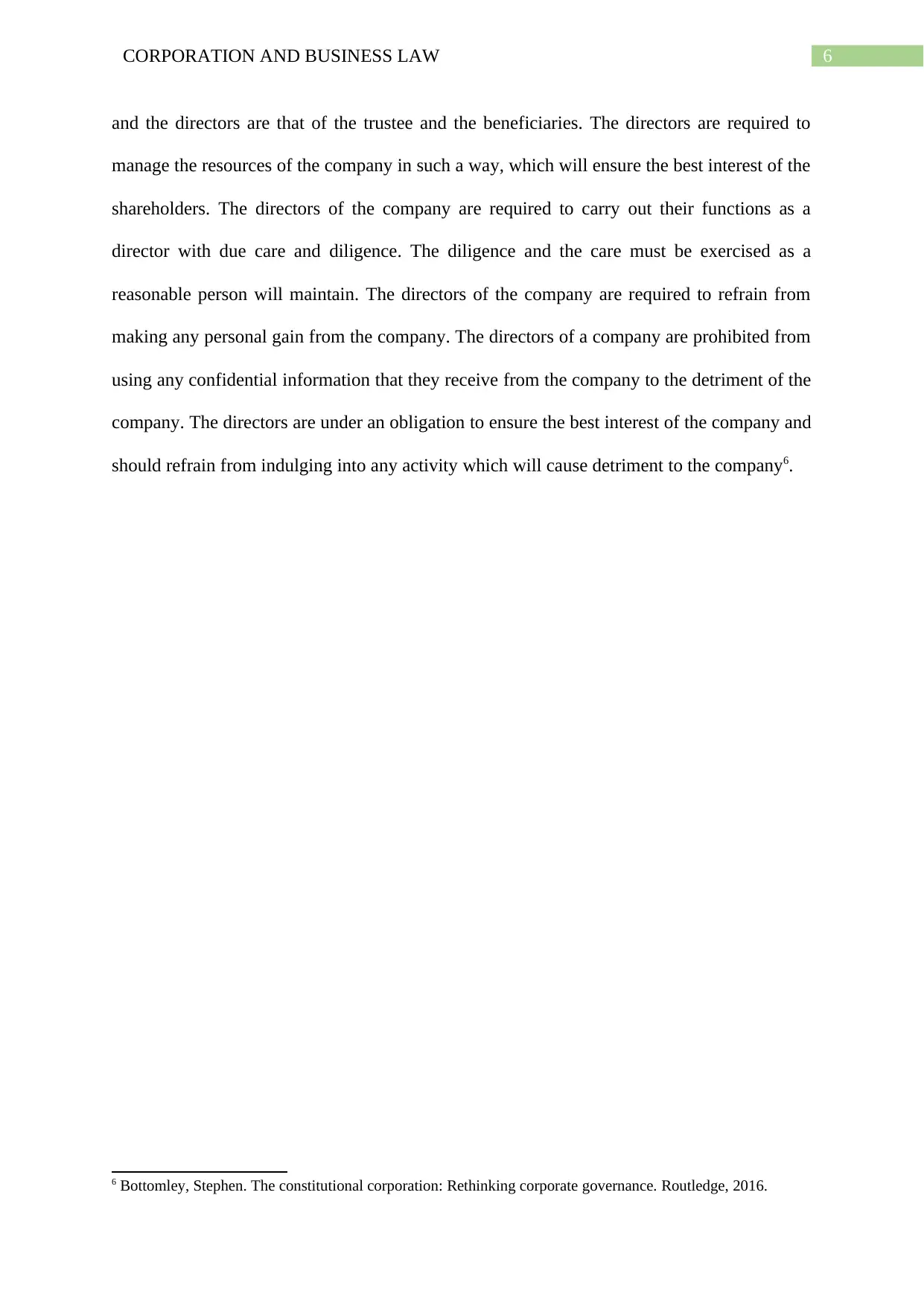
6CORPORATION AND BUSINESS LAW
and the directors are that of the trustee and the beneficiaries. The directors are required to
manage the resources of the company in such a way, which will ensure the best interest of the
shareholders. The directors of the company are required to carry out their functions as a
director with due care and diligence. The diligence and the care must be exercised as a
reasonable person will maintain. The directors of the company are required to refrain from
making any personal gain from the company. The directors of a company are prohibited from
using any confidential information that they receive from the company to the detriment of the
company. The directors are under an obligation to ensure the best interest of the company and
should refrain from indulging into any activity which will cause detriment to the company6.
6 Bottomley, Stephen. The constitutional corporation: Rethinking corporate governance. Routledge, 2016.
and the directors are that of the trustee and the beneficiaries. The directors are required to
manage the resources of the company in such a way, which will ensure the best interest of the
shareholders. The directors of the company are required to carry out their functions as a
director with due care and diligence. The diligence and the care must be exercised as a
reasonable person will maintain. The directors of the company are required to refrain from
making any personal gain from the company. The directors of a company are prohibited from
using any confidential information that they receive from the company to the detriment of the
company. The directors are under an obligation to ensure the best interest of the company and
should refrain from indulging into any activity which will cause detriment to the company6.
6 Bottomley, Stephen. The constitutional corporation: Rethinking corporate governance. Routledge, 2016.
Paraphrase This Document
Need a fresh take? Get an instant paraphrase of this document with our AI Paraphraser
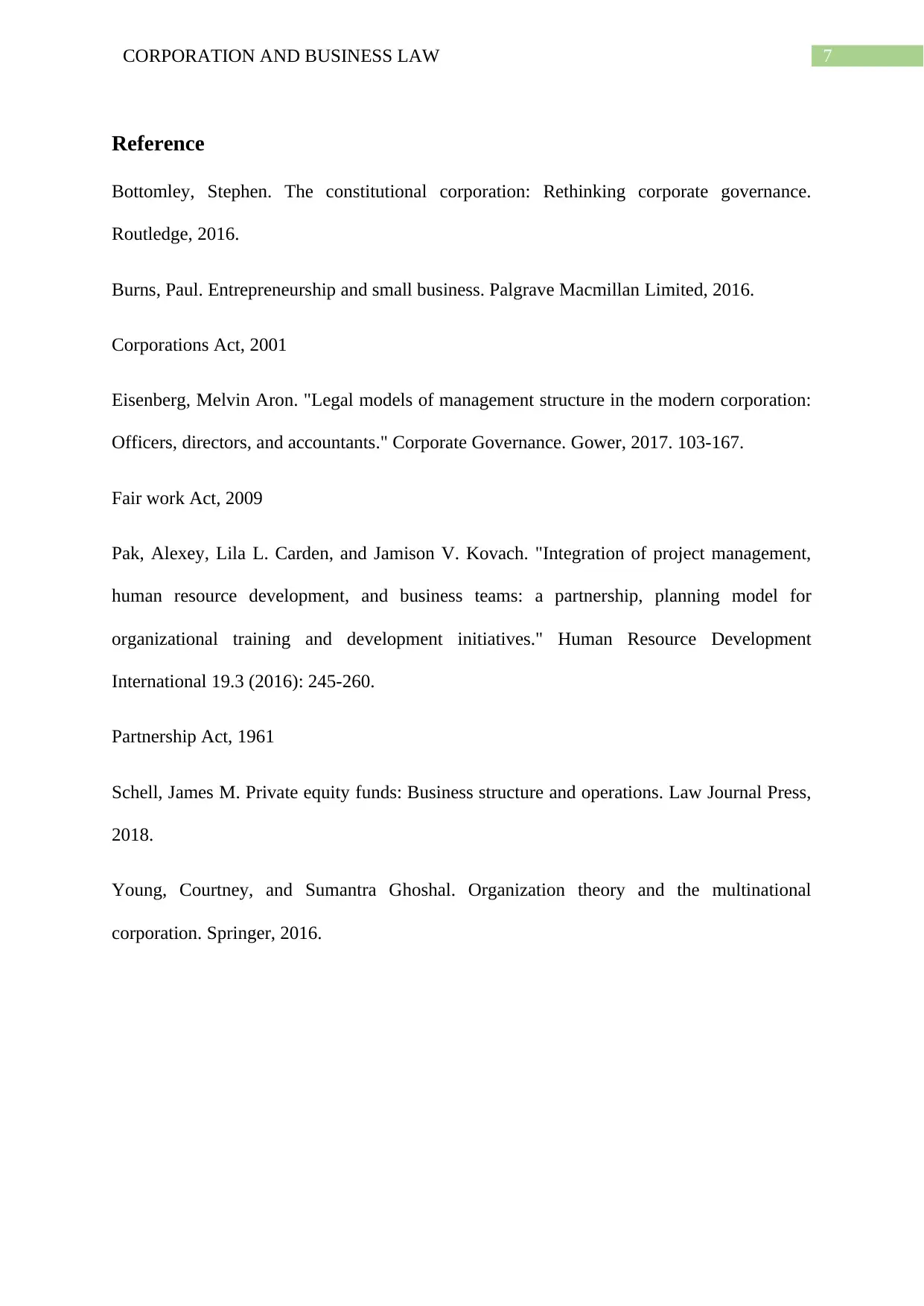
7CORPORATION AND BUSINESS LAW
Reference
Bottomley, Stephen. The constitutional corporation: Rethinking corporate governance.
Routledge, 2016.
Burns, Paul. Entrepreneurship and small business. Palgrave Macmillan Limited, 2016.
Corporations Act, 2001
Eisenberg, Melvin Aron. "Legal models of management structure in the modern corporation:
Officers, directors, and accountants." Corporate Governance. Gower, 2017. 103-167.
Fair work Act, 2009
Pak, Alexey, Lila L. Carden, and Jamison V. Kovach. "Integration of project management,
human resource development, and business teams: a partnership, planning model for
organizational training and development initiatives." Human Resource Development
International 19.3 (2016): 245-260.
Partnership Act, 1961
Schell, James M. Private equity funds: Business structure and operations. Law Journal Press,
2018.
Young, Courtney, and Sumantra Ghoshal. Organization theory and the multinational
corporation. Springer, 2016.
Reference
Bottomley, Stephen. The constitutional corporation: Rethinking corporate governance.
Routledge, 2016.
Burns, Paul. Entrepreneurship and small business. Palgrave Macmillan Limited, 2016.
Corporations Act, 2001
Eisenberg, Melvin Aron. "Legal models of management structure in the modern corporation:
Officers, directors, and accountants." Corporate Governance. Gower, 2017. 103-167.
Fair work Act, 2009
Pak, Alexey, Lila L. Carden, and Jamison V. Kovach. "Integration of project management,
human resource development, and business teams: a partnership, planning model for
organizational training and development initiatives." Human Resource Development
International 19.3 (2016): 245-260.
Partnership Act, 1961
Schell, James M. Private equity funds: Business structure and operations. Law Journal Press,
2018.
Young, Courtney, and Sumantra Ghoshal. Organization theory and the multinational
corporation. Springer, 2016.
1 out of 8
Related Documents
Your All-in-One AI-Powered Toolkit for Academic Success.
+13062052269
info@desklib.com
Available 24*7 on WhatsApp / Email
![[object Object]](/_next/static/media/star-bottom.7253800d.svg)
Unlock your academic potential
Copyright © 2020–2025 A2Z Services. All Rights Reserved. Developed and managed by ZUCOL.





